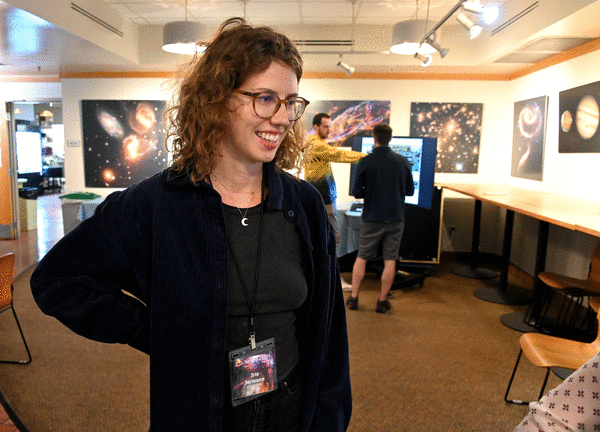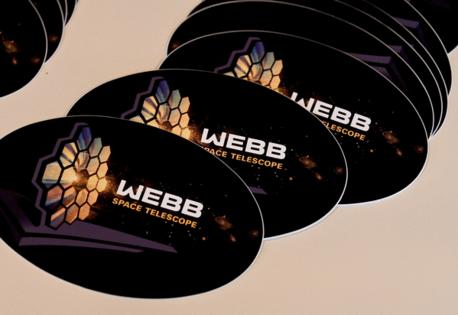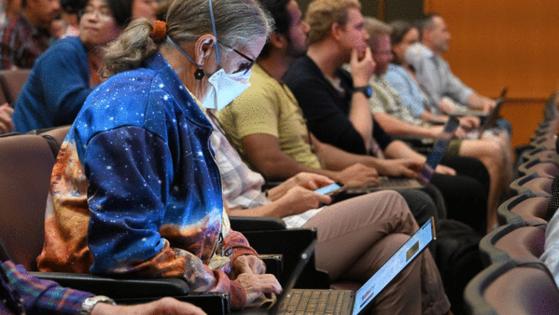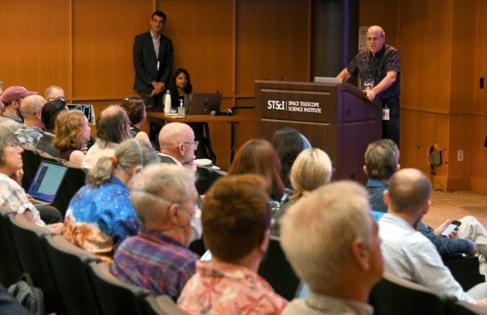
BALTIMORE — In many ways, the conference underway this week at the Space Telescope Science Institute in Baltimore is more like a celebration.
About one year into the science mission for the James Webb Space Telescope, the historic observatory is largely an awe-inspiring success.
Take, for instance, Marcia Rieke, the principal investigator in charge of the near-infrared camera aboard the observatory, called NIRCam. Rieke took the lectern Monday morning wearing a jacket printed with one of the first James Webb images to be released to the public: a capture of the “Cosmic Cliffs,” a star-forming region about 7,600 light-years from Earth in the Carina Nebula.
Her earrings were tiny replicas of the telescope’s primary mirror, a golden honeycomb made up of 18 hexagonal segments.
Speaking to the assembled crowd inside the auditorium, holding nearly 180 people, and a host of attendees watching online, Rieke described how the infrared camera, and other instruments aboard the telescope, are exceeding expectations.
From the moment scientists opened the orbiting Webb telescope’s powerful eyes to gaze at a star, they could see distant galaxies in the background, once hidden in the inky-black depths of space — showcasing the observatory’s power compared with its predecessors.

For that reason, images captured by Webb are instantly recognizable. So much so that when a French physicist shared an image last year on Twitter, claiming it was a star captured by James Webb, astronomers could tell immediately it was a prank. (It was actually a slice of chorizo.)
“Almost as soon as that appeared, people said: ‘No, that can’t be a real JWST image because there are no galaxies in the background,’” said Rieke, a professor at the University of Arizona.
Since the telescope’s launch on Christmas Day in 2021, the institute at the Johns Hopkins University in Baltimore has been its earthly home base. From a control room overlooking wooded Wyman Park and the waters of Stony Run, scientists carefully monitor the observatory’s status, ensuring that its various instruments are operating as planned.
The institute also sends all commands up to the telescope, determining where it will cast its gaze. After they’re dispatched from Charm City, the telescope’s marching orders are transmitted via one of the radio antennas in the Deep Space Network, which are located in Goldstone, California; Madrid; and Canberra, Australia.
Once the telescope collects the data, it is beamed back to Baltimore, where staff members distribute it to the scientists whose research the telescope was performing.
It’s therefore fitting to have the conference, which runs through Thursday, at the institute, said Macarena García Marín, the James Webb Space Telescope project scientist at the institute.

“It’s kind of a nice closing of the loop. Like, here is where you send the commands for the telescope to observe all those beautiful objects and then you get the data here, and it’s processed and it’s sent to the community,” she said. “And now we’re having the scientific community coming in, and having a meeting to explain: ‘Well, this is everything we’re finding.’”
Since the telescope arrived at its resting point 1 million miles away from Earth, and underwent several months of careful calibration, it has completed hundreds of missions, answering complex astronomical questions — and creating some new ones along the way.
During the opening of the conference Monday, Marc Postman, the interim deputy director at the Baltimore institute, called the telescope a “beacon of human achievement.”
“Over the past year, JWST users, including many among us here today, have published findings that require us to rethink our paradigms of planet, star and galaxy formation,” he said.
The list includes the discovery of massive, bright galaxies just a few hundred million years after the Big Bang, an indication that galactic formation took place faster than expected.
Webb also captured the first clear evidence of carbon dioxide in the atmosphere of a gas giant planet outside our solar system, showing off its power to uncover details about faraway planets and their formation.
Scientists also have used Webb to collect evidence backing up the Hubble constant, a measurement of the rate at which the universe expands, as captured by its predecessor, the Hubble Space Telescope. This is important because it deepens the mystery known as the Hubble tension, which arose when measurements from Hubble showed a faster rate of expansion than other instruments. The discrepancy could indicate that scientists are missing something, such as the presence of a unique particle or field that could be fouling some of the measurements.
“This is just a subset of the one year of science,” Postman said. “Imagine what the next 10 years will bring.”
And forecasts show that the telescope could send data back down to Earth for far longer. While initial, conservative estimates indicated the telescope would have enough fuel on board to last for 10 years, the propellant is now expected to last for more than 20, thanks to a very efficient launch, said Jane Rigby, senior project scientist for the Webb telescope.
“It still cool to me you can fire thrusters you’ve never fired before, and they can work to a percent. That’s neat,” Rigby said.
During her presentation Monday, Rigby provided a status update on the telescope. She said the telescope’s vision is more sensitive than expected, it is capturing less confounding stray light and it is more stable in space than anticipated.

“When I say things are going great,” she said, “here’s some documentation of what great looks like.”
However, she said, there are still some hiccups to work through. Evidence shows that the telescope’s Mid-Infrared Instrument, called MIRI, could be losing sensitivity over time, Rigby said, adding that scientists still are investigating the root cause of the anomaly.
As expected, the telescope also has been struck by about 50 “micro-meteoroids,” Rigby said. And while the vast majority of those hits caused negligible damage, one strike in May 2022 did damage the telescope.
So scientists have been trying to figure out how to ensure the telescope is less vulnerable to strikes, Rigby said.
“We have spent a lot of time trying to figure out: Why that one hit back in May — which you can see here is a dinner-plate-sized deformation of that segment that will be with us for the rest of the mission. What was up with that event?” Rigby said.
Rigby said operators have attempted to strategically adjust which way the telescope is pointed in order to protect the observatory, which cost roughly $10 billion to create. Efforts to construct it officially began in 2004, but were marred by a string of delays and cost overruns, all leading up to the launch at the end of 2021.
This year’s conference comes a bit more than a year after astronomers unveiled the telescope’s first full-color images at the Space Telescope Science Institute last summer, although President Joe Biden spoiled some of the action with a sneak preview at the White House. To attend, astronomers young and old arrived from near and far.
Iris Jermann traveled from Denmark, where she is a doctoral student at the Cosmic Dawn Center in Copenhagen. On Thursday, Jermann will present her research regarding cosmic “deep fields” captured by MIRI. But she is just as excited to discuss the findings of other scientists.
“What I like about conferences is we get out of our bubble,” Jermann said. “I get more when I listen to others. Like, what they’re doing … just seeing the bigger picture.”
The conference comes just before the latest deadline for scientists to propose new observations for Webb to complete. The due date is Oct. 25, after which panels of astronomers will select the experiments that the telescope will complete starting in the summer of 2024. So there will be plenty of discussion at the conference that shapes those proposals, García Marín said.
“It doesn’t even have to be at the conference. It could be over lunch,” she said. “When you sit with people and exchange ideas, you either get new ideas and new fresh ways of addressing a problem, or you realize that you have to change something.”
By: Christine Condon, The Baltimore Sun
©2023 The Baltimore Sun. Visit at baltimoresun.com. Distributed by Tribune Content Agency, LLC.







